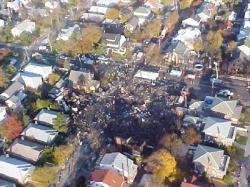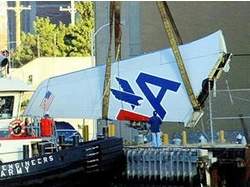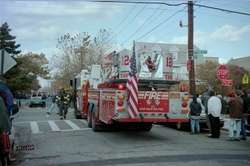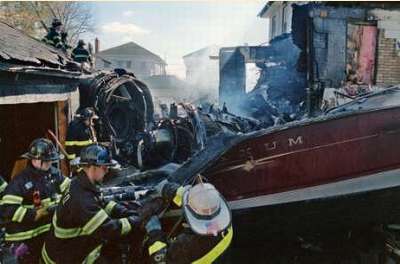...In The Wake Of AAL 587
 On November 12, 2001, about 0916:15
eastern standard time, American Airlines flight 587, an Airbus
Industrie A300-605R,1 N14053, crashed into a residential area of
Belle Harbor, New York, shortly after takeoff from John F. Kennedy
International Airport, Jamaica, New York. Flight 587 was a
regularly scheduled passenger flight to Las Americas International
Airport, Santo Domingo, Dominican Republic, with 2 flight
crewmembers, 7 flight attendants, and 251 passengers aboard the
airplane. The airplane’s vertical stabilizer and rudder
separated in flight and were found in Jamaica Bay, about 1 mile
north of the main wreckage site. The airplane’s engines
subsequently separated in flight and were found several blocks
north and east of the main wreckage site. All 260 people aboard the
airplane and 5 people on the ground were killed, and the airplane
was destroyed by impact forces and a postcrash fire. Flight 587 was
operating under the provisions of 14 Code of Federal Regulations
(CFR) Part 121 on an instrument flight rules flight plan. Visual
meteorological conditions prevailed at the time of the
accident.
On November 12, 2001, about 0916:15
eastern standard time, American Airlines flight 587, an Airbus
Industrie A300-605R,1 N14053, crashed into a residential area of
Belle Harbor, New York, shortly after takeoff from John F. Kennedy
International Airport, Jamaica, New York. Flight 587 was a
regularly scheduled passenger flight to Las Americas International
Airport, Santo Domingo, Dominican Republic, with 2 flight
crewmembers, 7 flight attendants, and 251 passengers aboard the
airplane. The airplane’s vertical stabilizer and rudder
separated in flight and were found in Jamaica Bay, about 1 mile
north of the main wreckage site. The airplane’s engines
subsequently separated in flight and were found several blocks
north and east of the main wreckage site. All 260 people aboard the
airplane and 5 people on the ground were killed, and the airplane
was destroyed by impact forces and a postcrash fire. Flight 587 was
operating under the provisions of 14 Code of Federal Regulations
(CFR) Part 121 on an instrument flight rules flight plan. Visual
meteorological conditions prevailed at the time of the
accident.
The National Transportation Safety Board determined that the
probable cause of this accident was the in-flight separation of the
vertical stabilizer as a result of the loads beyond ultimate design
that were created by the first officer’s unnecessary and
excessive rudder pedal inputs. Contributing to these rudder pedal
inputs were characteristics of the Airbus A300-600 rudder system
design and elements of the American Airlines Advanced Aircraft
Maneuvering Program (AAMP).

Prevention of High Loads Resulting From Pilot Rudder Pedal
Inputs
Rudder Pedal Inputs at High Airspeeds
Rudder control systems with a variable ratio rudder travel
limiter may provide better protection against high loads from
sustained rudder pedal inputs at high airspeeds than systems with a
variable stop rudder travel limiter because variable ratio rudder
travel limiter systems require more physical effort from a pilot
(in terms of force and displacement) to produce cyclic full rudder
inputs. For airplanes with variable stop rudder travel limiter
systems, protection from dangerous structural loads resulting from
sustained alternating large rudder pedal inputs can be achieved by
reducing the sensitivity of the rudder control system (for example,
by increasing the pedal forces), which would make it harder for
pilots to quickly perform alternating full rudder inputs.
 There is no certification standard
regarding rudder pedal sensitivity or any requirement for the
sensitivity to remain constant at all airspeeds. The Safety Board
concludes that certification standards are needed to ensure that
future airplane designs minimize the potential for aircraft-pilot
coupling (APC) susceptibility and to better protect against high
loads in the event of large rudder inputs. Accordingly, the Safety
Board believes that the Federal Aviation Administration (FAA)
should modify CFR Part 25 to include a certification standard that
will ensure safe handling qualities in the yaw axis throughout the
flight envelope, including limits for rudder pedal sensitivity. The
Safety Board further believes that, after the yaw axis
certification standard has been established, the FAA should review
the designs of existing airplanes to determine if they meet the
standard. For existing airplane designs that do not meet the
standard, the FAA should determine if the airplanes would be
adequately protected from the adverse effects of a potential APC
after rudder inputs at all airspeeds. If adequate protection does
not exist, the FAA should require modifications, as necessary, to
provide the airplanes with increased protection from the adverse
effects of a potential APC after rudder inputs at high
airspeeds.
There is no certification standard
regarding rudder pedal sensitivity or any requirement for the
sensitivity to remain constant at all airspeeds. The Safety Board
concludes that certification standards are needed to ensure that
future airplane designs minimize the potential for aircraft-pilot
coupling (APC) susceptibility and to better protect against high
loads in the event of large rudder inputs. Accordingly, the Safety
Board believes that the Federal Aviation Administration (FAA)
should modify CFR Part 25 to include a certification standard that
will ensure safe handling qualities in the yaw axis throughout the
flight envelope, including limits for rudder pedal sensitivity. The
Safety Board further believes that, after the yaw axis
certification standard has been established, the FAA should review
the designs of existing airplanes to determine if they meet the
standard. For existing airplane designs that do not meet the
standard, the FAA should determine if the airplanes would be
adequately protected from the adverse effects of a potential APC
after rudder inputs at all airspeeds. If adequate protection does
not exist, the FAA should require modifications, as necessary, to
provide the airplanes with increased protection from the adverse
effects of a potential APC after rudder inputs at high
airspeeds.
The Safety Board notes that the A300-600 yaw damper system
allows a pilot input to override a yaw damper command when the
rudder is at the full deflection limit permitted by the rudder
travel limiter system for a particular airspeed. Under these
conditions, a pilot input can override a yaw damper command in the
opposite direction and keep the rudder at the full deflection limit
by providing increasing pressure on the rudder pedals. Simulation
and flight data recorder data indicated that the first
officer’s rudder pedal inputs during the flight 587 accident
sequence were consistent with a suppression of yaw damper inputs at
the rudder deflection limits. The simulations indicated that, if
the yaw damper inputs had not been suppressed, the yaw damper would
have moved the rudder partially back toward neutral, thereby
lessening (but not preventing) the buildup of the sideslip angle
and aerodynamic loads on the vertical stabilizer.
 Such a delay could have provided an
additional level of safety because the initial response of the
airplane to a sustained rudder pedal input would not have been as
severe and could have reduced the chance of pilot surprise or
confusion.
Such a delay could have provided an
additional level of safety because the initial response of the
airplane to a sustained rudder pedal input would not have been as
severe and could have reduced the chance of pilot surprise or
confusion.
The Safety Board concludes that, because of its high sensitivity
(that is, light pedal forces and small pedal displacements), the
Airbus A300-600 rudder control system is susceptible to potentially
hazardous rudder pedal inputs at higher airspeeds. Therefore, the
Safety Board believes that the FAA should review the options for
modifying the Airbus A300-600 and the Airbus A310 to provide
increased protection from potentially hazardous rudder pedal inputs
at high airspeeds and, on the basis of this review, require
modifications to the A300-600 and A310 to provide increased
protection from potentially hazardous rudder pedal inputs at high
airspeeds.
Alternating Full Control Inputs
Alternating full inputs on the control wheel and rudder pedals,
such as those made by the first officer, should not be necessary to
control a transport-category airplane under any circumstance.
Industry literature (that is, the NRC report and Advisory Circular
[AC] 25-7A) indicates that an effective way to stop an APC event is
to cease the inputs. Recognition of an APC event by either the
pilot making the inputs or the nonflying pilot before structural
damage is crucial. However, according to the NRC report, pilots are
not trained to recognize the initial indications or to understand
that APC does not necessarily imply poor airmanship.
The Safety Board concludes that, to minimize the potential for
APC events, transport category pilots would benefit from training
about the role that alternating full control inputs can play in
such events and training that emphasizes that alternating full
rudder inputs are not necessary to control a transport-category
airplane. Therefore, the Safety Board believes that the FAA should
develop and disseminate guidance to transport-category pilots that
emphasizes that multiple full deflection, alternating flight
control inputs should not be necessary to control a
transport-category airplane and that such inputs might be
indicative of an adverse APC event and thus should be avoided.
Pilot Guidance on Design Maneuvering Speed
During this accident investigation, the Safety Board learned
that many pilots might have an incorrect understanding of the
meaning of the design maneuvering speed (VA) and the extent of
structural protection that exists when the airplane is operated
below this speed.
From an engineering and design perspective, maneuvering speed is
the maximum speed at which, from an initial 1 G flight condition,
16 the airplane will be capable of sustaining an abrupt, full
control input limited only by the stops or by maximum pilot effort.
In designing airplanes to withstand these flight conditions,
engineers consider each axis (pitch, roll, and yaw) individually
and assume that, after a single full control input is made, the
airplane is returned to stabilized flight conditions. Full inputs
in more than one axis at the same time and multiple inputs in one
axis are not considered in designing for these flight
conditions.

The American Airlines managing director of flight operations
technical told the Safety Board, during a post accident interview,
that most American Airlines pilots believed that the airplane would
be protected from structural damage if alternating full rudder
pedal inputs were made at an airspeed below maneuvering speed. The
American Airlines A300 fleet standards manager confirmed this
belief during public hearing testimony at the Board’s public
hearing for this accident. The Board notes that the American
Airlines A300 Operating Manual contained only one reference to
design maneuvering speed, which indicated that it was the
turbulence penetration speed (270 knots). However, as evidenced by
flight 587, cyclic rudder pedal inputs, even when made at airspeeds
below maneuvering speed, can result in catastrophic structural
damage.
Existing regulations and guidance pertaining to maneuvering
speed may have contributed to the misunderstanding regarding the
degree of structural protection provided by operating below
maneuvering speed. Title 14 CFR 25.1583, "Operating Limitations,"
lists maneuvering speed among the airspeed limitations that must be
furnished to the pilots of transport-category airplanes and states
that, along with maneuvering speed, pilots must also be furnished
"with a statement that full application of rudder and aileron
controls, as well as maneuvers that involve angles of attack near
the stall, should be confined to speeds below this value." Although
it is true that full control inputs should be confined to airspeeds
below maneuvering speed, the statement in Section 25.1583 could
also be read to incorrectly imply that an airplane could withstand
any such inputs so long as they were made below maneuvering speed.
The explanation of design maneuvering speed in AC 61-23C,
"Pilot’s Handbook of Aeronautical Knowledge," may be even
more misleading, stating that, "any combination of flight control
usage, including full deflection of the controls, or gust loads
created by turbulence should not create an excessive air load if
the airplane is operated below maneuvering speed." This statement
strongly -- and incorrectly -— suggests that, if multiple
control inputs were made below maneuvering speed, the airplane
would be protected against structural damage.
The Safety Board has no reason to believe that the
misunderstanding about maneuvering speed is limited to A300-600
pilots. As a result, the Safety Board concludes that there is a
widespread misunderstanding among pilots about the degree of
structural protection that exists when full or abrupt flight
control inputs are made at airspeeds below the maneuvering speed.
Therefore, the Safety Board believes that the FAA should amend all
relevant regulatory and advisory materials to clarify that
operating at or below maneuvering speed does not provide structural
protection against multiple full control inputs in one axis or full
control inputs in more than one axis at the same time.

Upset Recovery Training
In October 1996, the Safety Board issued Safety Recommendation
A-96-120, which recommended that the FAA "require 14 CFR Part 121
and 135 operators to provide training to flight crews in the
recognition of and recovery from unusual attitudes and upset
maneuvers, including upsets that occur while the aircraft is being
controlled by automatic flight control systems, and unusual
attitudes that result from flight control malfunctions and
uncommanded flight control surface movements."
More than 8 years have passed since the issuance of Safety
Recommendation A-96-120. Although the FAA has expressed agreement
with the intent of the recommendation, it has not yet taken the
necessary regulatory action to require unusual attitude training
for air carrier pilots. In contrast, the air carrier industry has
recognized the need for such training by voluntarily developing
programs, such as the American Airlines AAMP, and issuing the
Airplane Upset Recovery Training Aid. There is widespread agreement
among operations and training managers that unusual attitude
training helps prepare flight crews for such unusual situations.
However, without a regulatory requirement and published guidance
from the FAA, the design and adoption of such programs has been
voluntary, and approval of the principal operations inspector
assigned to the individual operators has been without the benefit
of broader guidance from training experts within the FAA.
The Safety Board’s investigation found deficiencies in the
American Airlines AAMP, including the following:
- ground school training that encouraged the use of rudder for
roll control,
- a simulator exercise in which pilots were encouraged to employ
large rudder inputs without being fully trained in the operating
properties of the specific rudder control system or fully
understanding the structural loads that might be imposed on the
airframe by certain inputs,
- a simulator exercise that provided unrealistic portrayals of an
airplane response to wake turbulence and significantly suppressed
control input effectiveness to induce a large rolling potential
that was unlikely to occur with an airplane as large as an
A300-600
- a simulator exercise that encouraged the use of rudder in a
highly dynamic situation without portraying the large buildup in
sideslip angle and sideload that would accompany such rudder inputs
in an actual airplane.
 ANN's Daily Aero-Linx (04.15.24)
ANN's Daily Aero-Linx (04.15.24) Classic Aero-TV: 'No Other Options' -- The Israeli Air Force's Danny Shapira
Classic Aero-TV: 'No Other Options' -- The Israeli Air Force's Danny Shapira Aero-News: Quote of the Day (04.15.24)
Aero-News: Quote of the Day (04.15.24) Airborne 04.16.24: RV Update, Affordable Flying Expo, Diamond Lil
Airborne 04.16.24: RV Update, Affordable Flying Expo, Diamond Lil ANN's Daily Aero-Term (04.16.24): Chart Supplement US
ANN's Daily Aero-Term (04.16.24): Chart Supplement US








